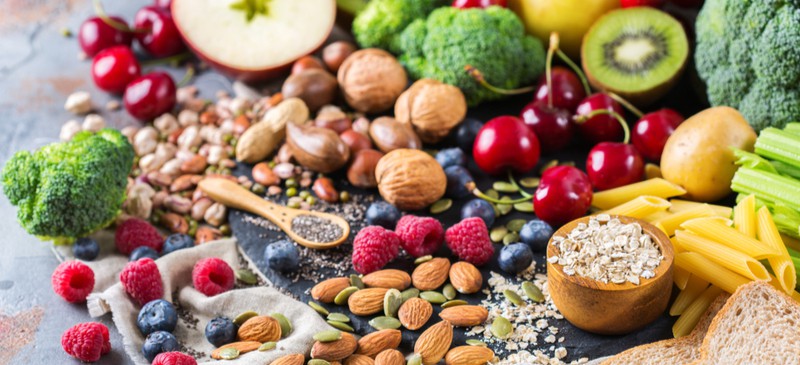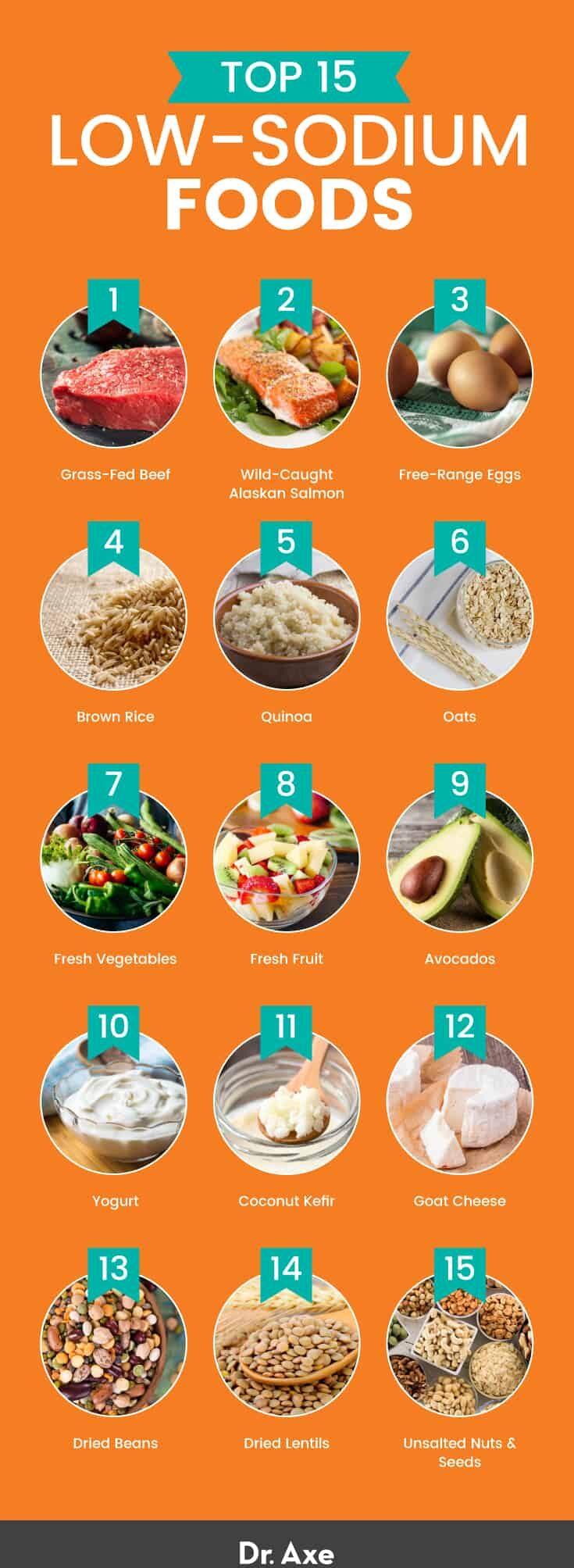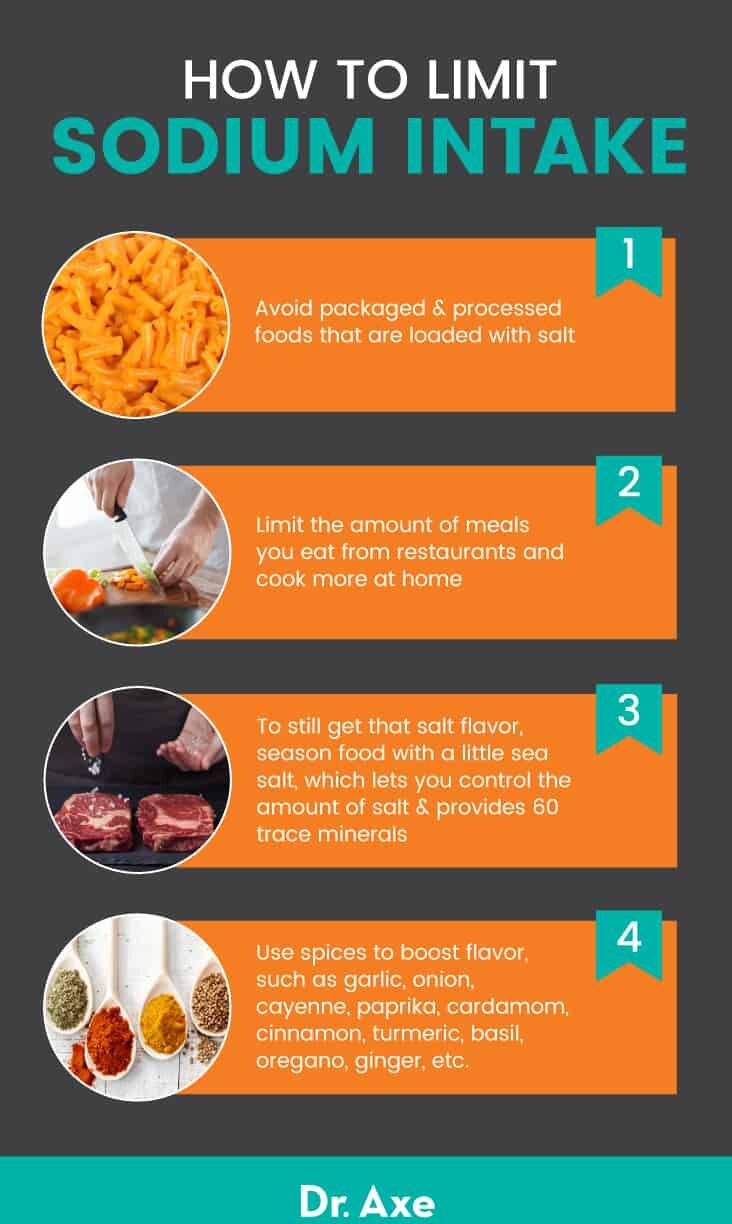Did you know that in Paleolithic times, humans consumed less than one gram of salt per day? Salt wasn’t added to foods for flavor the way it is today. Millions of years ago, humans got their salt from meat, which made up about 50 percent of their diet, while the other half was vegetables, some of the healthiest no or low-sodium foods.
It wasn’t until the Chinese discovered that salt could be used to preserve food, about 5,000 years ago, that salt became a precious commodity. Since then, salt consumption has increased tremendously, with people around the world eating nine to 12 grams per day. Today, over 75 percent of daily sodium intake comes from the salt that’s found in processed foods, and data shows that about 97 percent of U.S. adults consume more sodium than recommended by the Department of Health and Human Services.
A 2016 study published in the Journal of the American College of Cardiology indicates that there’s an increased risk of mortality for high sodium intake. Researchers concluded that there’s a clear benefit of reduced sodium intake, as it can literally save your life.
The science is clear, so why are so many people still eating too much sodium on a daily basis? Learning about low-sodium foods that can actually improve your health and ways to cut down on the amount of sodium being consumed can help tremendously, perhaps as part of a low-sodium diet.
Role of Sodium in Body
Sodium is an important nutrient in the body because it helps your nerves and muscles function properly. It maintains blood volume and blood pressure, and it’s involved in fluid balance in the body.
Ad

Sodium is one of the most critical electrolytes, so it’s needed in small amounts in order to avoid hyponatremia, which is low sodium levels in the blood. Hyponatremia and electrolyte imbalances develop in extreme heat and during exercise.
People exposed to very high temperatures or those exercising and losing a lot of fluids are at a higher risk of losing sodium through sweat and becoming deficient. This can lead to issues with muscle and nerve function.
But how much sodium per day do you need? According to research published the Journal of the American College of Cardiology, the amount of sodium needed to maintain homeostasis in adults is about 500 milligrams a day or less, which is exceedingly low compared to the average intake of sodium for most Americans, which is more than 3,200 milligrams.
Foods high in sodium begins with table salt. Salt is an ionic compounds that is composed of sodium chloride, which is 40 percent sodium and 60 percent chloride. According to the University of California San Francisco, the average American eats five or more teaspoons of salt every day, which is about 20 times more than the body needs. Your body really needs only about one-fourth teaspoon of salt per day.
So you may be wondering how to reduce your salt intake to just one-quarter teaspoon when you’re so used to eating salty foods. Bringing low-sodium foods into your diet can be extremely helpful, and so can dropping the packaged foods that are loaded with salt.
Benefits
1. Regulate Body Fluids
Eating low-sodium foods ensures that your balance of salt and water in the body remains regulated. Both sodium and potassium work to maintain normal water levels by attracting water and making sure that your cells and the areas around them are adequately hydrated.
Without enough sodium, fluid can enter your cells and cause them to burst. On the other hand, too much sodium in the body can lead to water retention, which causes swelling.
3. Control Blood Volume
The amount of sodium in your body affects the amount of fluid in your blood — this is called blood volume. The body monitors your sodium concentration and blood volume continuously, and when the levels become too high, the kidneys are stimulated to increase sodium excretion.
The body can handle too much sodium when it happens on occasion, but dealing with too much sodium on a regular basis begins to negatively affect your heart, blood vessels and kidneys.
When your sodium levels are too low, the kidneys stimulate your adrenal glands to secrete aldosterone, which triggers the kidneys to retain sodium and excrete potassium. Another way the body automatically reacts to low sodium levels is to stimulate the secretion of vasopressin by the pituitary gland. Vasopressin is commonly called the antidiuretic hormone because it causes the kidneys to conserve water, thereby conserving sodium as well.
4. Regulate Blood Pressure
By controlling your blood volume, the right amount of sodium in your body helps regulate your blood pressure levels. However, when you have too much sodium, this puts pressure on your veins and arteries, causing high blood pressure.
A 2013 systematic review and meta-analyses conducted in Switzerland found that lower sodium intake was associated with a reduced blood pressure and a reduced risk of stroke and fatal coronary heart disease in adults. Another analysis published in the American Journal of Hypertension found that modest reduction in salt intake resulted in a 20 percent decrease in cardiovascular and stroke events.
Best Low-Sodium Foods
For a food to be considered low in sodium, it should contain between 35 and 140 milligrams of sodium. Foods that contain less than 35 milligrams of sodium are considered very low-sodium foods. The following foods are not only low in sodium by these standards, but they also come with a slew of health benefits.
1. Grass-Fed Beef
A grass-fed beef patty contains about 45 milligrams of sodium, making it a low-sodium food. Grass-fed beef nutrition is quite impressive because it contains omega-3 fatty acids that help reduce inflammation and conjugated linoleic acid, which has shown cancer-fighting effects. Consuming grass-fed beef can help fight heart disease and cancer, improve blood sugar levels, and fight diabetes.
2. Wild-Caught Alaskan Salmon
A three-ounce piece of wild-caught salmon contains about 50 milligrams of sodium. Wild salmon that isn’t farmed is one of the healthiest foods you can find because it’s packed with omega-3 fatty acids, B vitamins, vitamin D, minerals like selenium and phosphorus, and protein. Salmon health benefits are vast, from supporting the health of your bones and joints to protecting your brain and neurological function.
Ad

3. Free-Range Eggs
One free-range egg contains about 70 milligrams of sodium. In addition to their low sodium content, the health benefits of eggs are numerous. Eggs contain omega-3 fatty acids that reduce your risk of heart disease, and they contain naturally occurring carotenoids that help prevent chronic illnesses.
4. Brown Rice
Brown rice doesn’t contain any sodium, but usually it’s prepared with a dash of salt. Try preparing your brown rice with just a little bit of sea salt and other spices like cayenne, paprika and turmeric for flavor.
Brown rice nutrition includes plenty of manganese, selenium and magnesium. Plus, it’s a good source of B vitamins that boost your energy levels and protect your heart.
READ RELATED: What Happens If You Eat Canned Food Every Day
5. Quinoa
One cup of cooked quinoa contains about 13 milligrams of sodium. Like brown rice, it’s usually prepared with salt, but try using just a sprinkle of sea salt or none at all, as quinoa has a great nutty flavor all by itself.
In case you’re not familiar with this low-sodium food, quinoa is known as gluten-free grain (although it’s technically a seed) that’s high in protein and fiber. It will help you to feel full for a longer period of time, so add quinoa to your meals to aid weight loss.
6. Oats
When you prepare your own raw steel-cut or rolled oats, they contain no sodium, while instant oatmeal packages can include up to 200 milligrams of sodium. Gluten-free oats are a great source of fiber and protein.
Compared to refined grains, oats have a low glycemic score, and they can help boost your immunity, aid digestion and lower cholesterol levels.
7. Fresh Vegetables
All fresh vegetables are considered low-sodium foods, and some contain very low sodium or no sodium at all. Artichokes, beets, celery, broccoli, sweet potatoes, spinach and bell peppers all contain less than 140 milligrams of sodium. Veggies that are very low in sodium include Brussels sprouts, collard greens, mushrooms and onion. And if you’re looking to enjoy vegetables with no sodium at all, go for asparagus, green beans, eggplant, garlic, cucumber and squash.
Keep it mind that the second you add sauce or seasoning to veggies, you’re increasing the sodium content, and vegetables prepared away from home usually contain a lot more sodium. Your best bet is to bake, stir-fry or steam these vegetables yourself, and then add just a dash a sea salt along with other flavorful spices.
8. Fresh Fruit
Fruit is naturally very low in sodium, so as long as it’s fresh and not preserved in a jar, can or cup, you’re good to go. Some of the best low- or no-sodium fruits include cantaloupe, honeydew, papaya, apples, bananas, grapefruit, pears, plums, watermelon, blueberries and strawberries.
9. Avocados
Half of a medium avocado contains only 10 milligrams of sodium. Avocados are a very low-sodium food that’s packed with healthy fats, fiber and phytochemicals that protect your body from disease. Many avocado benefits come from its monounsaturated fats that help regulate blood sugar levels and improve the health of your heart and brain.
10. Yogurt
One cup of yogurt contains about 115 milligrams of sodium. Yogurt is a probiotic food that supports healthy digestion and weight loss, increases bone density, and even helps keep anxiety and moodiness at bay. This low-sodium food also improves your cardiovascular health and boosts your immune system.
11. Coconut Kefir
One cup of coconut kefir contains about 60 milligrams of sodium. Coconut kefir is coconut water that has been fermented with kefir grains. It’s completely lactose- and gluten-free, and it’s packed with probiotics.
It also contains nutrients like vitamin B12, calcium, magnesium and potassium. Add this low-sodium food to a smoothie or your oatmeal to aid your digestion and boost your immune system.
12. Goat Cheese
An ounce of goat cheese contains 40 milligrams of sodium, making it a low-sodium food that can be added to salads, omelettes or vegetable dishes. Cheese made from goat milk is typically easier to digest because when goat milk enters the stomach, it forms a softer curd that causes less irritation when it’s being digested.
13. Dried Beans
Most dried beans contain no or very little sodium, as opposed to canned beans that typically contain well over 200 milligrams of sodium for 100 grams (less than half a can). Beans contain protein and fiber, and they are heart-healthy, may aid with weight loss and can help to fight diabetes. Some of the best options are kidney beans, fava beans, black beans, cannellini beans, adzuki beans and pinto beans.
14. Dried Lentils
A cup of dried lentils contains about 12 milligrams of sodium. Although lentils are also available in cans alone or in canned or boxed soups, buying them raw and cooking them yourself is definitely your best bet. You can add a dash of sea salt while cooking the lentils if you’d like. Lentils nutrition benefits include the ability to help you lose weight, boost your energy levels, improve your heart health and aid your digestion.
15. Unsalted Nuts and Seeds
Unsalted nuts and seeds contain no or very little sodium. Nuts and seeds serve as a great source of protein and fiber. They also contain protective antioxidants and important nutrients, like vitamin E, magnesium, calcium and iron.
Some of the best choices of unsalted nuts and seeds include almonds, walnuts, hazelnuts, chia seeds, flaxseeds and pumpkin seeds.
Low-Sodium Foods vs. High-Sodium Foods
Chances are, some of the foods that you eat every day are actually high in sodium. Just the way foods are prepared and packaged makes a huge difference, so take a look at this low-sodium foods vs. high-sodium foods list to be sure you’re making the right decisions when choosing your meals for the week.
Meat
- Low sodium: Fresh or frozen grass-fed beef, free-range chicken, organic lamb and wild-caught fish
- High sodium: Salted, smoked and cured meats, such as cold cuts, sausage, bacon, hot dogs, anchovies and sardines
Snacks
- Low sodium: Unsalted nuts and seeds, raw veggies, sliced apple, sliced cucumbers, carrot sticks, hard-boiled egg, and yogurt
- High sodium: Salted nuts, potato chips, salted pretzels, crackers and baked goods
Beans and Legumes
- Low sodium: Dry peas, lentils and beans
- High sodium: Canned beans and legumes
Dairy Products
- Low sodium: Yogurt, coconut kefir, raw cheeses, goat milk and cow milk
- High sodium: Processed cheeses, cheese spreads, cottage cheese and buttermilk
Bread and Grains
- Low sodium: Rice, pasta, oats, quinoa and plain bread
- High sodium: Quick breads, waffle, pancake and biscuit mixes, processed potatoes, rice and pasta mixes, salted crackers, pizza, and croutons
Fruits and Vegetables
- Low sodium: All fresh and frozen fruits and vegetables
- High sodium: Canned vegetables and vegetable juices, canned tomato sauce, pickled vegetables, olives, packaged potatoes with sauce or additives
Spices and Condiments
- Low sodium: Fresh garlic, basil, black pepper, cayenne pepper, chili powder, cinnamon, cumin, curry, dill, thyme, red pepper, parsley, paprika, nutmeg, oregano, lemon juice and vinegar
- High sodium: Salt, garlic salt, onion salt, taco seasoning, soy sauce, teriyaki sauce, Worcestershire sauce, horseradish, cocktail sauce and barbecue sauce
Low-Sodium Diet Guidelines
There can be many health-related dangers from eating high-sodium foods too often. In fact, high sodium can negatively affect several parts of the body, like your heart, kidneys and brain. Too much sodium may lead to high blood pressure and cause fluid retention, leading to swelling in your legs and feet. It can strain and damage your kidneys, reducing their ability to filter toxic wastes from the body.
When your blood pressure is raised because of excess sodium levels in the body, this also strains your arteries, heart and brain, making you more susceptible to health conditions like heart attack and dementia. The World Health Organization strongly recommends that people reduce their dietary salt intake as one of the top priority actions to decrease the number of deaths from hypertension, cardiovascular disease and stroke.
Over 70 percent of sodium in a person’s diet comes from processed and ultra-processed foods. Eating a diet high in processed foods is problematic alone, despite what it does to your sodium levels. Processed foods are made with refined carbohydrates, hydrogenated oils, hidden salt and sugar, and artificial ingredients.
It isn’t the sodium that’s added in food preparation or at the kitchen table that contributes so much to high sodium levels in the body, but restaurants are way more likely to have saltier foods. And in the last few decades, more and more people are eating out often.
To limit the amount of sodium in your diet, try the following dietary changes:
- Avoid packaged and processed foods that are loaded with salt. If you are using packaged foods, go for the low sodium options when they are available. When reading the food labels on packaged foods, look for sodium levels that are 140 milligrams of sodium per serving or less.
- Limit the amount of meals that you eat from restaurants. Cook more often at home so you can control the amount of salt that’s used in your meals.
- If you go from eating salty foods to preparing low-sodium recipes, you may notice a difference in flavor. This is a taste that you have probably become accustomed to over time, but small steps to reduce the salt in your foods can be helpful. For home-cooked meals, try adding a small amount of real sea salt. This gives you control over the amount of salt being used, and you’ll reap the benefits of the 60 trace minerals that are present in high-quality sea salt.
- Try using spices in your dishes to give it a boost of flavor. Garlic, onion, cayenne pepper, paprika, cardamon, cinnamon, turmeric, basil oregano, ginger, black pepper and nutmeg are just a few of the spices and herbs that add to the flavor of a meal without the need for extra salt.
Precautions
Keep in mind when eating a low-sodium diet that come people are at a higher risk of developing hyponatremia, or very low sodium levels. People with heart, kidney and liver problems; those taking diuretics, antidepressants and pain medications; and people who are losing fluids quickly by sweating, vomiting or experiencing diarrhea should be careful to eat enough sodium every day.
If you are at risk, speak to your healthcare professional about how much sodium you should be consuming daily.
Final Thoughts
- Sodium is an important nutrient in the body because it helps your nerves and muscles function properly, maintains blood volume and blood pressure, and is involved in fluid balance in the body. However, 97 percent of U.S. adults consume more sodium than recommended by the Department of Health and Human Services.
- To reduce your daily sodium intake, eat low-sodium foods like fresh fruits and vegetables, oats, quinoa, grass-fed beef, unsalted nuts and seeds, dried beans, and yogurt.
- Eat more home-cooked meals to reduce sodium levels, as packaged foods and meals served in restaurants are typically much higher in sodium.
- Sticking to a low-sodium diet will provide the body with electrolytes, help to regulate body fluids, regulate blood pressure, control blood volume, and support your muscle and nerve function.
!function(f,b,e,v,n,t,s)
{if(f.fbq)return;n=f.fbq=function(){n.callMethod?
n.callMethod.apply(n,arguments):n.queue.push(arguments)};
if(!f._fbq)f._fbq=n;n.push=n;n.loaded=!0;n.version=’2.0′;
n.queue=[];t=b.createElement(e);t.async=!0;
t.src=v;s=b.getElementsByTagName(e)[0];
s.parentNode.insertBefore(t,s)}(window, document,’script’,
‘
fbq(‘init’, ‘3475171552810057’);
fbq(‘track’, ‘PageView’);








